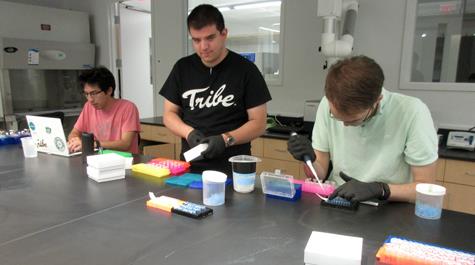BOV hears progress on engineering & design program initiative
Vice Provost for Research Dennis Manos and two faculty members updated William & Mary’s Board of Visitors on progress on its initiative in engineering and design.
Manos and Professor of Business James R. Bradley were co-chairs of a committee charged by Provost Michael Halleran with recommending ways to incorporate “design thinking” into the university’s curriculum. The committee delivered its 125-page report in June, along with a synopsis.
Manos cautioned the Board at Thursday’s meeting that the intent of the initiative was not to form an engineering school or even to offer degrees in engineering.
“Our intent is to leverage our strengths by blending two great complementary forces at William & Mary,” Manos said, “namely, faculty expertise with liberal arts education and student desire to use technology to change and to improve the world.”
Manos told the board that his committee is beginning work on three “first fruits” tasks — infrastructure, data science and engineering physics & applied design.
Manos addressed the infrastructure aspect, which builds on the “maker” ethos that has permeated William & Mary. Manos notes there are makerspaces in a number of locations: Small Hall, the School of Education, Swem Library’s Reeder Media Center, the Integrated Science Center, the Mason School of Business, Morton Hall, Andrews Hall and the Applied Research Center.
“The count is not easy to do. There are now 15 distinct areas that we call makerspaces — located in rooms in seven different buildings in Williamsburg and Newport News, and another space at VIMS,” he said. “I just learned that in room 220 and 221 of Andrews, acoustic and electronic sensors will be developed, along with autonomous vehicles.”
These community DIY labs are filled with tools such as laser cutters, 3-D printers, computer-controlled devices, virtual reality equipment — and people who know how to use them. They’ve become natural incubators of collaboration and creativity.
The briefing was part of the Provost’s Report segment of the Board’s Sept. 22 meeting. Two members of the committee, Dan Miller Runfola, AidData geospatial scientist, and Bill Cooke, professor of physics, outlined proposed additions to the curriculum.
Runfola outlined proposals for new engineering-oriented curricular offerings, including a minor, and eventually a major program, in data science. These new fields of concentration would open up access to computational-analytical skills and techniques to a wider group of William & Mary students.
He told the Board of the challenges met by students who tried to craft independent majors that would give them solid data science backgrounds. He presented a slide that showed a student who wanted to take Introduction to Simulation, a necessary data-science course, would have to wade through seven prerequisites.
It would be a natural progression for a math or computer science major, he said, but a data science track would smooth out such curricular bumps in the road.
Cooke told the Board about a proposal for a new engineering-oriented track to the B.S. in physics. He said the proposed Engineering Physics and Applied Design curriculum would benefit the large proportion of physics graduates who go directly into industry—about 30 percent of William & Mary graduates, but 40 percent nationally. The new track would keep a deep background in science, while adding courses in practical areas such as design, simulation and business.
“This puts us directly at the intersection of technology and humanities,” William & Mary Rector Todd A. Stottlemyer ’85 said following the presentation. “That’s exciting.”
Speaking in advance of the presentation to the Board of Visitors, Manos pointed out that engineering is a William & Mary tradition. The committee’s written report outlines the institution’s engineering history. In 1930, William & Mary offered a complete line of engineering education. The legislature even appended “Virginia Polytechnic Institute” to William & Mary’s title. W&M’s engineering programs migrated to a satellite campus in Norfolk, a school that later became the independent Old Dominion University. The “Virginia Polytechnic Institute” appellation, of course, transferred to the land-grant school in Blacksburg.
The engineering tradition is alive and well at the university today, Manos said. Much of William & Mary’s research could be legitimately classified as engineering, and Manos points out there are at least a dozen terminal engineering degrees among the faculty.
The developing program is being tailored to be relevant to William & Mary’s undergraduate curriculum, adding aspects of practical competence to any major. With a commitment to resources, some courses in an engineering and design program could be available by fall 2017, members of the committee said. The provost has asked the relevant deans and vice provost Manos to submit specific plans, with budgets, for these two programs by the end of the semester so that they can be evaluated and considered in the budget development.
“This is incredibly important work,” commented President Taylor Reveley. “And you all are doing a marvelous job of getting into it. This really, really matters to the future of William & Mary. Deliver quickly!”


